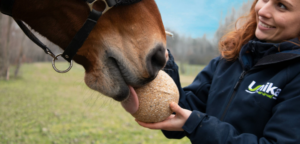
UNIKA BALLS: THE SUPPLEMENT THAT COMBINES FUN AND WELL-BEING
If you have ever walked through the stables or along…
Feed and products in 25kg bags excluded
Bank transfer | Paypal | Credit cards

Nowadays if you analyse the foods composing a sporthorse’s diet, you may easily notice that the amount of biotin they provide is scarce and variable. In other words, biotin is poorly present in plants. After several years of researches on this sulphurated (meaning that it contains sulphur) vitamin, a new analytical parameter was defined: modern texts now report “available biotin”, not “total biotin”. Thanks to this distinction it is easy to notice that the amount of biotin the horse actually absorbs from food is way lower than expected, for biotin is often chemically bounded to substances that do not easily release it in the body. Therefore, total biotin and available biotin significantly differ in amount. The greatest sources of biotin are high-protein foods, while a diet containing great amounts of barley provides a very small quantity of available biotin. That is the reason why the quality and growth of the keratinous structures of both hooves and other parts of horses whose diet is rich in cereals, such as barley, brans and wheat (the poorest source of available biotin), is poor or even worsens.
The table below shows that the amount of available biotin is higher in foods, such as dehydrated alfalfa, brewers’ yeast and dehulled soybean meal. The table values are expressed in micrograms (µg) per kilogram of raw material (a microgram is one thousandth of a milligram). Therefore, the quantities reported can only be measured with very sophisticated lab equipment and are invisible to the eye.
| RAW MATERIAL
|
TOTAL BIOTIN
µg/kg |
AVAILABLE BIOTIN
µg/kg |
% AVAILABLE BIOTIN/ TOTAL BIOTIN
µg/kg |
| BARLEY | 180 | 12 | 6 |
| OAT | 190 | 50 | 26 |
| WHEAT | 100 | 4 | 4 |
| CORN | 100 | 65 | 65 |
| CORN GLUTEN (40% PROTEINS) | 150 | 90 | 60 |
| SOFT WHEAT BRAN | 100 | 15 | 15 |
| RICE BRAN | 380 | 12 | 3.1 |
| BREWERS’ YEAST | 970-1100 | 300 | 27 |
| SOYBEAN MEAL, DEHULLED | 350 | 280 | 80 |
| DEHYDRATED ALFALFA | 250-350 | 200-300 | 85 |
| MIXED HAY | 70 | 10 | 7 |
Let’s imagine feeding a horse with a very good ration made up of:
Total amount of available biotin: 892 µg/day, quantity that equals 0.8-0.9 mg/kg of available biotin per day. Since Roche’s estimated a daily requirement of 20 mg/day, it seems clear that horses suffer from constant available biotin deficiency.
Therefore, supplementation with synthetic biotin is necessary if the horse is fed with the above raw materials, feeds based on those raw materials and cereal-based rations, which are essential to provide the energy it needs for sport activities.

If you have ever walked through the stables or along…

Colic is one of the most common and delicate issues in horse care.

Thanks to its anti-inflammatory, anti-oedemigenous and pain-relieving properties, it is perfect for protecting horses’ osteoarticular well-being.

The use of clay dates back to very ancient times and even today it has not lost its fame as a natural remedy with a thousand uses.

The warm season is upon us and for many riders it is time to take the clipper in hand…

Here we are at our second meeting with our Unika Blog Naturopathy section. I am Sara Maiani, specialized in Natural Medicine, Clinical Phytotherapy and Naturopathy.